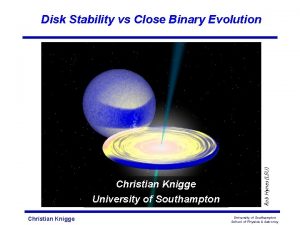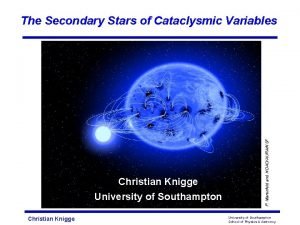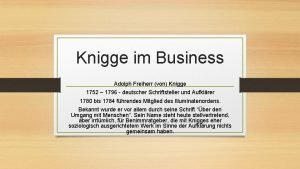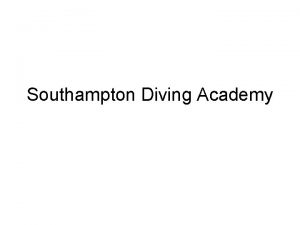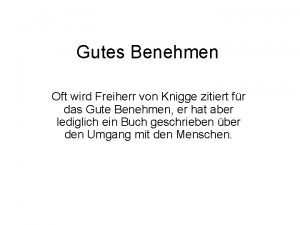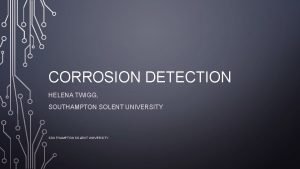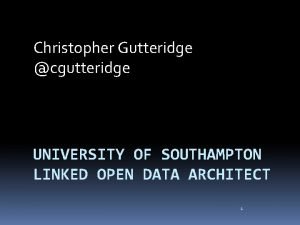Christian Knigge University of Southampton Christian Knigge P













- Slides: 13

Christian Knigge University of Southampton Christian Knigge P. Marenfeld and NOAO/AURA/NSF Low-Mass and Substellar Donors in Interacting Cataclysmic Compact. Variables Binary Systems University of Southampton School of Physics & Astronoy

Outline • Introduction – Cataclysmic Variables: A Primer • The Donor-Driven Evolution of CVs – The stellar response to mass loss – The origin of the “period gap” • How can we learn from each other? – Example 1: Magnetic Braking – Example 2: Star spots & differential rotation – Example 3: The effect of irradiation of (sub)stellar & planetary atmospheres • Summary Christian Knigge University of Southampton School of Physics & Astronoy

Cataclysmic Variables: A Primer The Physical Structure of CVs • White dwarf primary Red Dwarf White Dwarf • Main-sequence(ish) secondary • Roche-lobe overflow • Accretion usually via a disk • 75 mins < Porb < 12 hrs Accretion Disk Credit: Rob Hynes Christian Knigge • Mass transfer & evolution driven by angular momentum losses • Evolution is (initially) from long to short periods University of Southampton School of Physics & Astronoy

Cataclysmic Variables: A Primer The Orbital Period Distribution and the Standard Model of CV Evolution Knigge 2006 • Clear “Period Gap” between 2 -3 hrs • Suggests a change in the dominant angular momentum loss mechanism: – Above the gap: • Magnetic Braking • Fast AML High – Below the gap: • Gravitational Radiation • Slow AML Low • Minimum period at Pmin ≈ 80 min – donor transitions from MS BD – beyond this, Porb increases again • Howell, Nelson & Rappaport 2003 Christian Knigge So CV donors evolve along the MS! This is the “standard model” of CV Evolution University of Southampton School of Physics & Astronoy

Should donors be on the main sequence? The stellar response to mass loss • In CVs, , so the donor cannot shrink quite fast enough to keep up with the rate at which mass is removed from its surface • The secondary is therefore driven slightly out of thermal equilibrium, and becomes somewhat oversized for its mass Stehle, Ritter & Kolb 1996 Does any of this actually matter? Yes: this slight difference is key to our understanding of CV evolution! Christian Knigge University of Southampton School of Physics & Astronoy

The Donor-Driven Evolution of CVs The Origin of The Period Gap • Thought to be due to a sudden reduction of magnetic-braking-driven AML when the donor becomes fully convective • This reduces • Donor responds by relaxing closer to its equilibrium radius • This causes loss of contact and cessation of mass transfer on a time-scale of • Orbit still continues to shrink (via GR), while donor continues to relax • Ultimately, Roche lobe catches up and mass transfer restarts at bottom edge • All of this only works if the donor is significantly bloated above the gap and increases Is there any observational evidence for all this? Christian Knigge University of Southampton School of Physics & Astronoy

The Donor-Driven Evolution of CVs The Empirical Donor Mass-Radius Relationship Patterson et al. (2005), Knigge (2006), Knigge et al (2011) M-R relation based on eclipsing and “superhumping” CVs • Donors are significantly larger than isolated MS stars both above and below the gap • Clear discontinuity at M 2 = 0. 20 M☼, separating long- and short-period CVs! – Direct evidence for disrupted angular momentum loss! – Change in MB efficiency across fully-convective boundary! Christian Knigge University of Southampton School of Physics & Astronoy

How Can We Learn From Each Other? Example 1: Magnetic Braking • All of CV evolution is driven by angular momentum losses • Magnetic braking is critical in this respect – Basic physics is straightforward • The donor drives a weak wind that co-rotates with donor’s B-field out to the Alfven radius • This spins down the donor and ultimately drains AM from the orbit – Magnetic braking is almost certainly dominant above the period gap – It is usually assumed to stop when donor becomes fully convective, but some residual MB may also operate below the gap • Certainly implied by observations of activity in single/detached fully convective stars So how well do we understand magnetic braking? Christian Knigge University of Southampton School of Physics & Astronoy

How Can We Learn From Each Other? Example 1: Magnetic Braking Matt et al. 2015 Knigge, Baraffe & Patterson 2011 Christian Knigge University of Southampton School of Physics & Astronoy

Inverting the Donor Mass-Radius Relation A Magnetic Braking Recipe based on CV Donors • Main Results • Above the gap, a slightly suppressed RVJ MB recipe works well -- is this consistent with MB in single stars? ? ? • Below the gap, need roughly ≈2. 5 x. GR! Knigge, Baraffe & Patterson 2011 Christian Knigge -- MB in fully convective / sub-stellar objects? University of Southampton School of Physics & Astronoy

How Can We Learn From Each Other? Example 2: Star Spots and Differential Rotation Main Results • Significant spot coverage • Spots appear preferentially - Near L 1 point Irradiation? Smith, Dunford & Watson 2012 - At high latitudes Polar spots e Lo St w at • Exception: V 426 Oph? • Same pattern in the donor of a neutron star X-ray binary • Multi-epoch observations DR • AE Aqr: ~265 day lap time Cen X-4 (NS LMXB) Christian Knigge imperfect synchronization University of Southampton School of Physics & Astronoy

How Can We Learn From Each Other? Example 3: Strongly Irradiated Substellar & Planetary Atmospheres Hernandez Santisteban, Knigge et al. 2015, in prep • Average donor temperature Reprocessing Efficiency = 1 – Bond Albedo Teff ~ 2000 K L 1 Sp. T ~ • Clear irradiation signatures – Photometric: reflection effect – Spectroscopic: water bands • Inferred Bond albedo ≈ 0 reprocessing efficiency ≈1 – In line with models of lowmass stars and brown dwarfs! Christian Knigge University of Southampton • Day/night temperature School of Physics & Astronoy

Summary • CV donors are fantastic laboratories for stellar physics – They are synchronised, so we know their (fast!) rotation rates – They are Roche-lobe-filling, so we know their shape and can use this to infer their star spot patterns – They lose mass, so we can use them to study the stellar response to mass loss – Their evolution is driven by magnetic braking, so we can use them to test/infer MB recipes – They evolve across the fully convective boundary, so we can test for changes in stellar properties and activity across the boundary – They evolve across the Hydrogen-burning limit, so we can directly observe the transition from the stellar to the sub-stellar regime – Their primaries are nearby and often luminous , so we can use them to study the effect of irradiation on (sub)stellar and planetary atmospheres Christian Knigge University of Southampton School of Physics & Astronoy
 Christian knigge
Christian knigge Christian knigge
Christian knigge Sei vorsichtig im tadel und
Sei vorsichtig im tadel und University of southampton enabling services
University of southampton enabling services Thomas knigge
Thomas knigge Pgr tracker soton
Pgr tracker soton Eprints southampton
Eprints southampton Street homeless prevention team southampton
Street homeless prevention team southampton Southampton township school district
Southampton township school district Population of southampton 2021
Population of southampton 2021 Southampton county, virginia plantations
Southampton county, virginia plantations Sussed southampton login
Sussed southampton login New vevox app
New vevox app Southampton geothermal heating company ltd
Southampton geothermal heating company ltd
